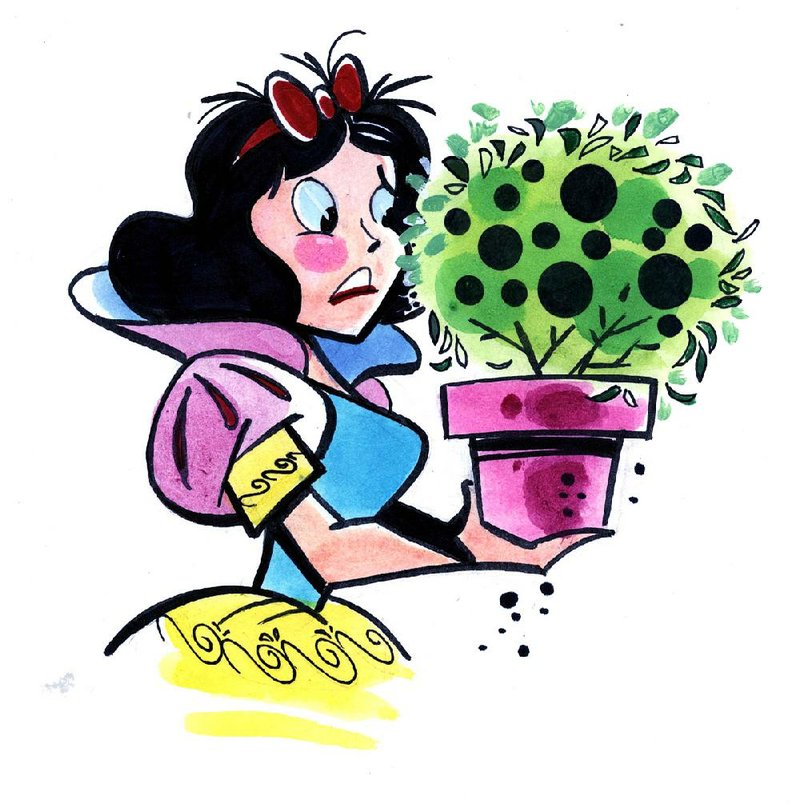Q I planted "Snow White" Indian hawthorn plants in spring 2014 as part of a landscape builder's package. Late in the season, they developed black spot on the leaves. I applied fungicide directly to the leaves and worked a Bayer product into the soil. I am having the same problem this spring/summer. Is there any remedy or will I have to dig up and destroy them? I am also concerned that this disease could spread to other plantings.
A Indian hawthorn plants are lovely evergreen shrubs, but they are susceptible to entomosporium leaf spot, the same disease that has wiped out many of our red tip photinias. Our recommendation is to plant disease-resistant varieties -- which you did, as "Snow White" is on the resistant list. Others include "Eleanor Tabor," "Clara," "Blueberry Muffin," "Dwarf Yedda," "Eskimo," "Georgia Charm," "Indian Princess," "Jack Evans" and "Majestic Beauty." Some seasons may have a bigger disease pressure than other years. You can try spraying with a fungicide containing chlorothalonil (such as Daconil) next year as new growth is beginning, wait two to three weeks and spray again, and then see what happens. Preventive sprays are often more productive than curative ones. Entomosporium leaf spot is a disease most commonly seen on red tips and Indian hawthorn, but it can be seen on flowering quince, pyracantha and ornamental pears. Rarely does it kill Indian hawthorns, but they aren't at their most attractive with spots, and heavy infestations can make them drop a lot of leaves.
Q I just planted two crape myrtles in my parking strip that the city of Portland sold me. Sadly, each has only one trunk. Should I let some suckers grow up to make more trunks, or am I doomed to a one-trunk crape myrtle? I don't understand how they even make them like that, or try to; the whole point is the beautiful shape of them.
A Although crape myrtles are often sold as trees with several trunks, they can be beautiful single-trunked trees as well. Many crape myrtle species sucker at the base, and if you want a tree with multiple trunks, you could simply let some of the suckers grow -- as long as they are spaced far enough apart.
Q We bought a ginkgo tree this spring and planted it in our front yard in a spot that drains fairly well. The tree is about 10 feet tall and has plenty of leaves and a beautiful shape. My concern is that the leaves are beginning to look ever so slightly yellow, and by that I mean just barely, but they just don't look quite as green as they did. We live in Dardanelle at the foot of Mount Nebo, and like everyone else, we have had tons of rain followed by several 90-degree days in the past couple of weeks. Do you have any advice on the tree?
A I recently saw a number of large shade trees in Northwest Arkansas that were chlorotic -- they had yellowing leaves with green veins. Otherwise, they looked fine. Typically, that is a pH issue. The soil pH is usually getting too high (or in some cases too low). Have your soil tested to ensure that the pH is in the proper range, and then wait and see what happens. If you are fertilizing the lawn, the tree should be getting some fertilizer as well, which can aid in green-up.
Q We have fuzzy white clusters on the limbs of a Japanese maple. Can you tell me what to do and whether it will damage the plant? When sprayed with insecticide, the babies hop off and go to another plant.
A We continue to get more and more questions about white woolly aphids. They seem to be out in record numbers this year. The heavy rains we had last week may have helped knock them down, but they can be controlled with insecticidal soap or Malathion.
Q I am growing my first hostas. I have them planted in a large planter in my yard. Do I bring them inside in the winter, or will they survive outside?
A Hosta plants are hardy perennials in Arkansas, so they should overwinter just fine. They will die back to the ground in the winter and reappear the following spring. In large containers or planters, they should do fine, but if they are growing in small containers, you may need to protect the roots. I have been growing some in pots for years, and they do fine with no help. Make sure you fertilize them several times during the growing season. Keep them watered when they get dry, and you should be good to go.
Janet B. Carson is a horticulture specialist for the University of Arkansas Cooperative Extension Service. Write to her at 2301 S. University Ave., Little Rock, Ark. 72204 or email her at
jcarson@arkansasonline.com
HomeStyle on 07/11/2015
